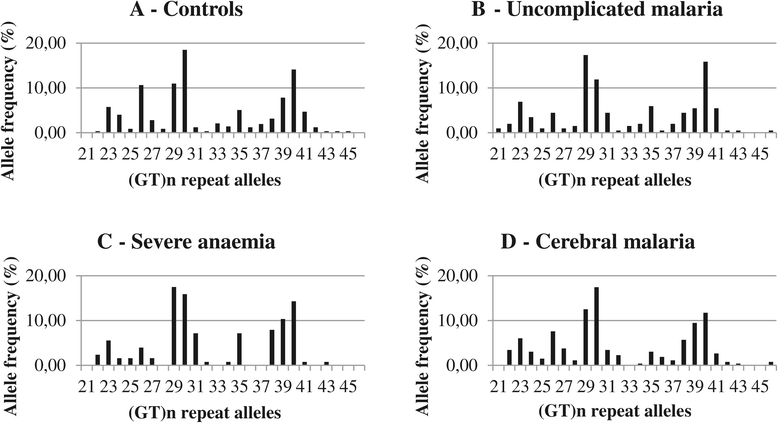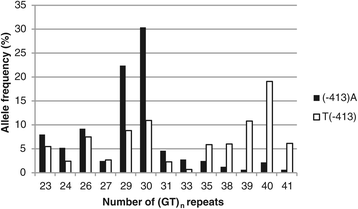Polymorphisms in the Haem Oxygenase-1 promoter are not associated with severity of Plasmodium falciparum malaria in Ghanaian children
- PMID: 25888733
- PMCID: PMC4396170
- DOI: 10.1186/s12936-015-0668-5
Polymorphisms in the Haem Oxygenase-1 promoter are not associated with severity of Plasmodium falciparum malaria in Ghanaian children
Abstract
Background: Haem oxygenase-1 (HO-1) catabolizes haem and has both cytotoxic and cytoprotective effects. Polymorphisms in the promoter of the Haem oxygenase-1 (HMOX1) gene encoding HO-1 have been associated with several diseases including severe malaria. The objective of this study was to determine the allele and genotype frequencies of two single nucleotide polymorphisms; A(-413)T and G(-1135)A, and a (GT)n repeat length polymorphism in the HMOX1 promoter in paediatric malaria patients and controls to determine possible associations with malaria disease severity.
Methods: Study participants were Ghanaian children (n=296) admitted to the emergency room at the Department of Child Health, Korle-Bu Teaching Hospital, Accra, Ghana during the malaria season from June to August in 1995, 1996 and 1997, classified as having uncomplicated malaria (n=101) or severe malaria (n=195; defined as severe anaemia (n=63) or cerebral malaria (n=132)). Furthermore, 287 individuals without a detectable Plasmodium infection or asymptomatic carriers of the parasite were enrolled as controls. Blood samples from participants were extracted for DNA and allele and genotype frequencies were determined with allele-specific PCR, restriction fragment length analysis and microsatellite analysis.
Results: The number of (GT)n repeats in the study participants varied between 21 and 46 with the majority of alleles having lengths of 26 (8.1%), 29/30 (13.2/17.9%) and 39/40 (8.0/13.8%) repeats, and was categorized into short, medium and long repeats. The (-413)T allele was very common (69.8%), while the (-1135)A allele was present in only 17.4% of the Ghanaian population. The G(-1135)A locus was excluded from further analysis after failing the Hardy-Weinberg equilibrium test. No significant differences in allele or genotype distribution of the A(-413)T and (GT)n repeat polymorphisms were found between the controls and the malaria patients, or between the disease groups, for any of the analysed polymorphisms and no associations with malaria severity were found.
Conclusion: These results contribute to the understanding of the role of HMOX1/HO-1. This current study did not find any evidence of association between HMOX1 promoter polymorphisms and malaria susceptibility or severe malaria and hence contradicts previous findings. Further studies are needed to fully elucidate the relationship between HMOX1 polymorphisms and malarial disease.
Figures


References
MeSH terms
Substances
LinkOut - more resources
Full Text Sources
Other Literature Sources
Miscellaneous

